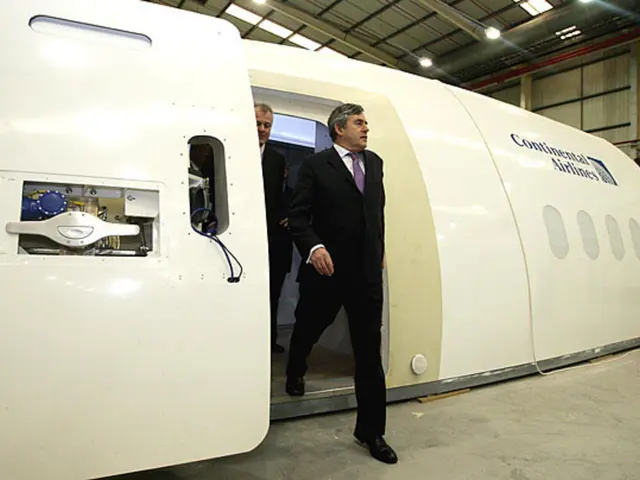Economic Capital as a Key Production Factor: An Examination
Getting Down to Business: Understanding Capital
Let's dive right in and discuss capital from a layman's perspective. In simple terms, capital refers to the wealth possessed by individuals or businesses that is available for a specific purpose, such as starting a company or making investments. This wealth can be in the form of cash, securities, factories, machinery, or equipment.
Capital plays a crucial role in both companies and the economy as a whole. Physical capital contributes to the production of goods and services directly, while companies need financial capital to buy the necessary items like machinery and machines. For instance, when starting a new business, you need initial capital to purchase essential items or rent a production site. This capital can come from savings, family, loans, or other sources.
Do money and other financial capital count as factors of production in economics? Let's find out.
Why is Capital Important?
Physical capital is indispensable for businesses. As businesses accumulate more capital by purchasing new machines, for example, we expect an increase in output. To illustrate, a business might have initially 10 machines producing 100 units per hour each, totaling 1,000 units per hour. Now, the company has 12 machines of the same capacity, allowing it to produce 1,200 units per hour. This increase is due to an increase in the number of machines.
Quality also matters. Companies can increase production capacity by purchasing more technologically advanced machines. For instance, new technology could enhance a machine's production capacity from 100 to 120 units per hour. With the same number of machines, the company can produce more goods and services because they are of higher quality.
More sophisticated machines also lead to increased worker productivity. For example, a manufacturing company could produce output quickly using computer-aided machines, as computers help the production process run automatically and require less technical intervention from workers.
Does running a business consist of physical capital alone? No, financial capital is equally important. It, too, comes in various types.
Financial Capital
Financial capital is as vital as physical capital in operating a business, even though it doesn't contribute directly. New businesses need start-up capital to purchase necessary equipment or lease production sites. This capital can come from personal savings or external loans.
Then, when the business is operational, the company needs working capital to purchase raw materials, pay bills to suppliers, and build inventory. This working capital, often referred to as the difference between current assets (cash and asset items that can be converted into cash) and current liabilities (short-term debt and trade payables), is essential for meeting daily needs.
When a business becomes successful, its owner may want to grow the company. To achieve this, they pursue strategies to increase their competitive and income-generating capacity. This growth can be achieved through internal or external expansion.
Expansion requires financial capital. Thus, companies often issue stock or debt securities to finance expansion, perhaps by acquiring other companies or building new production facilities.
By growing, the business increases its production capacity. With this increased capacity, companies can produce and sell more products. Furthermore, companies can benefit from economies of scale, enabling them to produce at lower costs, which is essential for maintaining competitiveness.
Can money spent lead to an increase in the company's production capacity or not? Let's compare capital expenditures with the depreciation of fixed assets.
Depreciation represents the lost economic benefits of fixed assets over time due to wear and tear. For example, a machine's production capacity might be 100 units when newly purchased but could be only 90 due to its age and condition.
Thus, if capital expenditures exceed depreciation, we can expect capacity to increase. Conversely, if the capital expenditure is lower than the depreciation rate, the production capacity decreases.
Capital in Economics – The Factors of Production
Now, let's explore capital from an economist's perspective.
Economists define capital as man-made tools used to produce goods and services. This definition refers to physical capital, such as machinery, equipment, and vehicles. It does not include money or financial capital.
In economics, capital is one of the four factors of production, alongside land, labor, and entrepreneurship. All four are essential inputs for producing goods and services. Without them, there would be no production or business. The reward for capital in this context is interest.
Why do economists exclude financial capital as a factor of production?
Financial capital, such as money, does not contribute directly to production. For example, a business cannot transform money into cars as aluminum is a raw material. Or, they cannot use it##### to help process raw materials into cars. Have you ever seen a car manufacturer produce cars using money instead of robotic machines and workers?
Instead, businesses use financial capital like cash, equity capital, and debt indirectly in the production process. Specifically, money only facilitates economic transactions. For example, in manufacturing cars, as in the case above, they need it to buy raw materials (aluminum) and capital goods (machinery).
Financial Capital in Company Reports
Both physical capital and financial capital are reported in financial statements, which record the resources owned by a company and claims to those resources. So, where can we find capital as defined by economists?
First, let's discuss financial capital. In accounting, financial capital is divided into two main categories: equity and debt.
- Equity represents the capital contributed by shareholders and indicates ownership of the company. It is long-term capital. As compensation, shareholders receive dividends distributed by the company and can earn capital gains from stock price appreciation.
- Debt comes from creditors, such as banks and debt securities investors. It can be short-term or long-term. Examples include bank loans, commercial paper, notes, and bonds. The company is obligated to repay the principal plus interest.
Both equity and debt are part of the liabilities and equity section of the balance sheet. When analyzing a company's growth prospects and solvency, analysts typically focus on long-term capital, as growing a business is a long-term project.
Next, let's discuss physical capital. It refers to fixed capital. In financial statements, you may find it under a property, plant, and equipment (PP&E) account. Companies use it to produce products. In buying fixed assets, companies rely on long-term financial capital, such as issuing shares or debt securities. The money raised can be used to buy fixed assets. This expenditure is known as capital expenditure (CAPEX). The amount spent determines if the current productive capacity is maintained or increased. As I explained before, we need to compare CAPEX with depreciation to see the impact of capital expenditure on increasing production capacity.
Sources:
[1] Investopedia. (2018, October 8). Capital goods. Investopedia. https://www.investopedia.com/terms/c/capitalgoods.asp
[2] Kent, J. J., & Smith, P. J. (2017). Introductory microeconomics. Cengage Learning.
[3] Lakonishok, M. A., Shleifer, A., & Vishny, R. W. (1994). Common risk factors in the returns on stocks and bonds. The Journal of Finance, 49(1), 427-464.
[4] Mankiw, N. G. (2017). Principles of economics: An introductory textbook. Cengage Learning.
[5] Delavan, L. (2005). Plant and equipment. Investopedia. https://www.investopedia.com/terms/p/plantandequipment.asp
[6] Larson, M., & Larson, R. C. (2015). Managerial economics: Business decision making (12th ed.). McGraw Hill Education.
- In the realm of personal-finance and education-and-self-development, understanding different types of capital, such as financial, is essential for making smart investment decisions in starting a new business or growing an existing one.
- As businesses grow, they often need to invest in technological advancements, which can lead to increased production capacity and improved output quality – factors that are critical for remaining competitive in the business world.
- Understanding the role of capital in economics, both physical and financial, is crucial for analyzing company reports and making informed investment decisions. By examining a company's balance sheet, one can assess the combination of financial capital (equity and debt) and physical capital (property, plant, and equipment) to gain insights into its financial health and growth prospects.








